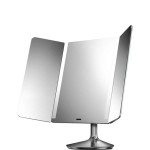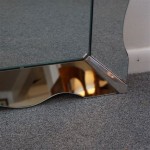Mirror iPhone to Samsung TV: Troubleshooting Audio, But No Video
Mirroring an iPhone to a Samsung TV offers a convenient way to share photos, videos, and presentations on a larger screen. However, users sometimes encounter a frustrating issue: the audio streams successfully, but the video remains absent, displaying only a black screen or a "No Signal" message. This article explores the common causes behind this problem and provides a comprehensive guide to troubleshooting it effectively.
Several factors can contribute to the "audio only" mirroring scenario. These include compatibility issues, network connectivity problems, incorrect settings on either the iPhone or the Samsung TV, outdated software, and even hardware limitations. Understanding these potential culprits is the first step towards resolving the issue.
Checking Compatibility and Connection Methods
The first step in troubleshooting the "audio only" problem is to ensure that the iPhone and Samsung TV are compatible with the chosen mirroring method. Several methods are available, each with its own compatibility requirements and potential pitfalls. These methods include AirPlay, Smart View (or similar Samsung mirroring features), and third-party mirroring applications.
AirPlay: AirPlay is Apple's proprietary wireless streaming protocol. To use AirPlay, both the iPhone and the Samsung TV must support it. While most newer Samsung TVs include AirPlay 2 support, older models may not. Check the Samsung TV's specifications to confirm AirPlay compatibility. An iPhone 5 or newer is generally required for AirPlay functionality. Ensure both devices are connected to the same Wi-Fi network.
Smart View (or Similar): Samsung Smart TVs often have their own mirroring features, such as Smart View. These features rely on the TV's operating system and are generally compatible with Android devices. While some Samsung TVs may offer limited support for iOS devices through Smart View, it's often less reliable than AirPlay. If using Smart View or a similar Samsung-specific feature, verify that the iPhone is properly detected and that the mirroring process is initiated correctly from the TV's interface.
Third-Party Apps: Numerous third-party applications are available on the App Store that facilitate screen mirroring. These apps often offer broader compatibility across different brands of TVs. However, their performance and reliability can vary. When using a third-party app, ensure it is specifically designed to mirror iOS devices to Samsung TVs and that it is up-to-date. Also, review the app's permissions and security settings to mitigate potential privacy risks.
Once a connection method is chosen, verifying the Wi-Fi network connection is crucial. Both the iPhone and the Samsung TV should be connected to the same network. A stable and reliable Wi-Fi signal is essential for successful screen mirroring. Weak or intermittent Wi-Fi can lead to video dropouts or the complete absence of video, while the audio stream might still be maintained due to its lower bandwidth requirements.
To assess network stability, consider running a speed test on both the iPhone and the Samsung TV. This can help identify potential bandwidth limitations or network congestion issues. Moving the devices closer to the Wi-Fi router, or restarting the router, can also improve network performance.
Investigating Settings and Configuration
Incorrect settings on either the iPhone or the Samsung TV can also cause the "audio only" problem. These settings can interfere with the mirroring process and prevent the video signal from being transmitted or displayed correctly. Carefully reviewing the settings on both devices is essential.
iPhone Settings: On the iPhone, check the display settings to ensure that screen mirroring is enabled and configured correctly. Look for options related to AirPlay or screen mirroring in the Control Center or under the Display & Brightness settings. Verify that the correct Samsung TV is selected as the mirroring destination. If multiple devices are available, mistakenly choosing the wrong device can lead to connection problems.
Additionally, check the iPhone's "Do Not Disturb" settings. Enabling "Do Not Disturb" can sometimes interfere with AirPlay and screen mirroring functionality. Temporarily disabling "Do Not Disturb" can help determine if this is the cause of the problem.
Samsung TV Settings: On the Samsung TV, navigate to the settings menu and look for options related to screen mirroring, AirPlay, or external devices. Ensure that screen mirroring is enabled and that the TV is set to accept connections from external devices. Some Samsung TVs may have specific settings for AirPlay, such as requiring a password for connections. If a password is required, make sure it is entered correctly on the iPhone.
Furthermore, check the TV's input source. Ensure that the correct input source is selected for the device attempting to mirror the screen. Sometimes, the TV may automatically switch to the correct input, but this is not always the case. Manually selecting the correct input source can resolve video display issues.
Another potential setting to investigate is the TV's picture settings. Some picture modes or settings may not be compatible with screen mirroring. Try switching to a different picture mode, such as "Standard" or "Movie," to see if this resolves the issue. Additionally, check the TV's resolution settings. If the resolution is set too high, it may exceed the iPhone's capabilities, resulting in video display problems. Experiment with different resolution settings to find one that works correctly.
Addressing Software and Hardware Limitations
Outdated software or hardware limitations can also contribute to mirroring problems. Keeping both the iPhone and the Samsung TV up-to-date with the latest software is crucial for optimal performance and compatibility.
Software Updates: Regularly check for software updates on both the iPhone and the Samsung TV. Software updates often include bug fixes and performance improvements that can resolve mirroring issues. On the iPhone, go to Settings > General > Software Update to check for available updates. On the Samsung TV, navigate to the settings menu and look for options related to software updates or firmware upgrades.
It's important to note that software updates can sometimes introduce new problems. If the mirroring issue started after a recent software update, consider researching whether other users have reported similar problems. In some cases, reverting to a previous version of the software may be necessary, although this is generally more complex and may require technical expertise.
Hardware Limitations: Older iPhones or Samsung TVs may have hardware limitations that prevent them from supporting certain mirroring features or resolutions. For example, an older iPhone may not be powerful enough to stream high-resolution video to a Samsung TV. Similarly, an older Samsung TV may not support the latest AirPlay protocols or mirroring standards.
In such cases, there may be no easy solution to the problem. Upgrading to a newer iPhone or Samsung TV may be necessary to achieve reliable screen mirroring. Alternatively, consider using a different mirroring method that is less demanding on the hardware, such as mirroring at a lower resolution.
Another potential hardware-related issue is the HDMI cable, if the mirroring is done through a wired connection using an adapter. A faulty or incompatible HDMI cable can prevent the video signal from being transmitted correctly. Try using a different HDMI cable to see if this resolves the issue. Ensure that the HDMI cable is properly connected to both the iPhone and the Samsung TV.
Furthermore, if using a Lightning to HDMI adapter, ensure that it is a genuine Apple adapter or a certified third-party adapter. Non-certified adapters may not be fully compatible with iOS devices and can cause mirroring problems.
In addition to the above points, consider the following:
- Restart both devices: A simple restart can often resolve temporary glitches that may be interfering with the mirroring process.
- Close unnecessary apps: Running too many apps on the iPhone can strain its resources and affect mirroring performance. Close any unnecessary apps before attempting to mirror the screen.
- Factory reset: As a last resort, consider performing a factory reset on the Samsung TV. This will restore the TV to its original factory settings and may resolve any software-related issues that are preventing screen mirroring from working correctly. However, be aware that a factory reset will erase all of your TV's settings and preferences, so be sure to back up any important data before proceeding.
Troubleshooting Specific Error Messages
Sometimes, the Samsung TV may display specific error messages that can provide clues about the cause of the problem. Pay close attention to these error messages and research them online to find potential solutions.
"No Signal": A "No Signal" error message typically indicates that the TV is not receiving a video signal from the iPhone. This can be caused by a faulty HDMI cable, an incorrect input source selection, or a problem with the iPhone's video output settings. Ensure that the HDMI cable is securely connected and that the correct input source is selected on the TV. Also, check the iPhone's display settings to ensure that video output is enabled.
"AirPlay Connection Failed": An "AirPlay Connection Failed" error message indicates that there is a problem with the AirPlay connection between the iPhone and the Samsung TV. This can be caused by network connectivity issues, incorrect AirPlay settings, or compatibility problems. Ensure that both devices are connected to the same Wi-Fi network and that AirPlay is enabled on both devices. Also, check the Samsung TV's AirPlay settings to ensure that the iPhone is authorized to connect.
"Unsupported Format": The error message "Unsupported Format" means that the video format that the iPhone is sending is not supported by the TV. Try changing the output resolution from the iPhone. If these solutions do not solve the issue, consider converting the video to a more compatible format before attempting to mirror the screen.
By systematically troubleshooting these potential causes, users can often identify and resolve the "audio only" mirroring problem and enjoy a seamless screen mirroring experience from their iPhone to their Samsung TV.

Screen Mirroring Sound But No Picture Fixed In 2024

Screen Mirroring Sound But No Picture Fixed In 2024

Why My Tv Has No Sound When Screen Mirroring From Iphone Or Ipad

Why My Tv Has No Sound When Screen Mirroring From Iphone Or Ipad

Airplay Audio Only Heres How To Get Back

How To Screen Mirror Or Cast Iphone Samsung Tv

Airplay Audio Only Heres How To Get Back

Screen Mirroring Sound But No Picture Fixed In 2024

How To Screen Mirror Iphone Your Samsung Tv

Now You Can Stream Iphone To Samsung Smart Tvs Without Airplay Updated Apple Must







